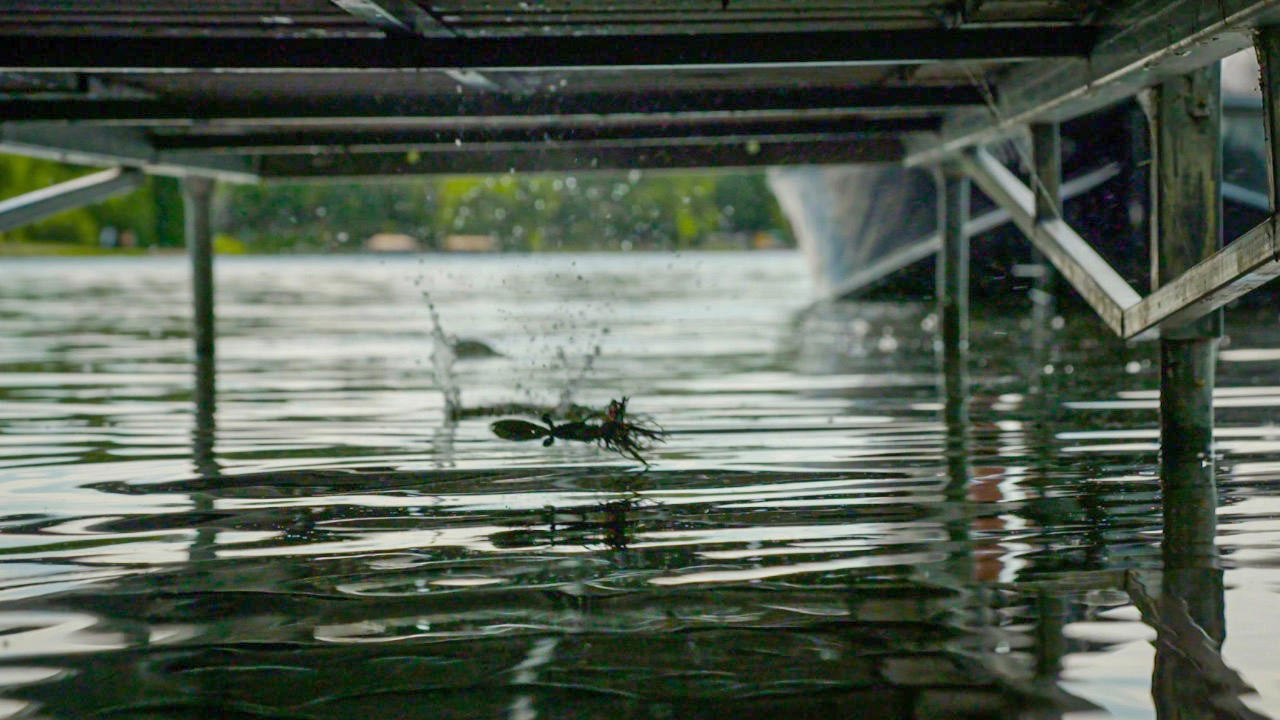Skipping a jig underneath boat docks is an outstanding way to catch big fish throughout much of the year. Whether you’re fishing in the heat of the summer or in the coldest part of winter, you can bet there will be some quality bass hanging out under docks. This pattern is certainly no secret, however, which leads to heavy fishing pressure and wary bass.
This is exactly why it’s so important to make the casts other anglers aren’t making. A lot of anglers can get their jigs a few feet underneath a boat dock, but the biggest bass are often found in the deepest, darkest shade they can find. It takes a lot of practice and the right gear to quietly and accurately get your jig into these hard-to-reach places.
TACKLE USED:
- Daiwa Tatula Elite Casting Rod, 7’1″ Heavy
- Daiwa Tatula 100 Casting Reel, 8.1:1
- Seaguar AbrazX Fluorocarbon, 17lb Test
- Z-Man David Walker’s CrosseyeZ Flippin’Jig
- Strike King KVD Perfect Plastics Rodent
- Strike King Hack Attack Heavy Cover Swim Jig
- Biwaa Armored Craw
- Fish Monkey Gloves
In this video, I go through my preferred gear for this specialized technique. Although I prefer to keep things as simple as possible for most of my fishing, skipping boat docks does require some certain gear considerations.
Above all, your rod selection is perhaps the most critical aspect in regards to skipping boat docks. A lot of anglers like to use heavy-action rods for this technique, but I actually prefer a little lighter action when I’m skipping jigs. I’ve been using the 7-foot, 1-inch heavy-action Daiwa Tatula Elite for the past several months and it has allowed for some incredibly accurate casts. Although it’s labeled as a heavy-action casting rod, it has a considerably lighter action than most other heavy-action rods I’ve tested throughout my career. I’d probably describe it as a heavy-action medium-heavy, if that makes sense.
Regardless of what particular rod you choose, it’s important to make sure it has enough backbone to wrench fish out of thick cover but enough tip to facilitate an effective bend on your back cast. These types of rods can be tough to find, so when you find one that works for you, don’t be afraid to buy multiples if you can afford them.
You jig selection is also an important decision. It’s imperative to understand that not all jigs are created equal. There are dozens of different head shapes and designs to choose from, so the process can get a bit daunting at times. I prefer a 1/2-ounce Z-Man CrossEyeZ Flippin’ Jig for almost all of my dock skipping. It features a flat section on the underside of the head which allows for seamless skips without a second thought. The head is shaped similarly to the river rocks we used to skip as kids, so it’s able to skip across the water without breaking the surface tension. Using a similar head shape will allow you to skip your jig into incredibly tough-to-reach places without spooking nearby bass.
When it’s time to choose a soft-plastic trailer for your jig, I suggest steering clear of baits with a bunch of appendages. These appendages will catch too much water when your jig makes contact with the surface, which will cause a drastic decrease in both your casting distance and accuracy. Personally speaking, I rely on both the Strike King Rodent and the 4-inch Biwaa Armored Craw when skipping boat docks. You’ll notice that both options have a very streamlined profile without many appendages or flanges. Simplicity is king in this situation.
I’ve experimented a lot with different line diameters over the years and I’ve finally settled on one particular line size when I’m skipping boat docks. Regardless of water clarity, I prefer using 17-pound fluorocarbon for this application because it blends two critical traits I look for—strength and manageability. If you were to downsize to a 15-pound fluorocarbon, you’re bound to break off in thick cover. Upsizing to a 20- or 25-pound fluorocarbon, however, can lead to serious line management issues. While this heavier fluorocarbon is an outstanding option for pitching and flipping heavy cover, it’s a bit thick for long-distance skipping. After a lot of trial and error, I’ve found 17-pound fluorocarbon to be a happy medium for me.
Because everyone has vastly different preferences for casting reels, don’t get caught up on what other people are using when it comes to skipping docks. What works for your buddy may not be a good fit for you, so keep an open mind when you’re choosing a reel. Whatever you end up choosing, just make sure it’s easy to adjust and features a high gear ratio. The higher the gear ratio, the more IPT (inches per turn) you’re going to get. I suggest no lower than a 7.0:1 gear ratio and if you can get into that 8.1 range, that’s even better.
When you’re learning to skip docks, try your hardest to remain patient. You’re going to get backlashes. You’re going to waste line (I’d start out with cheap line when you’re learning). You’re going to get frustrated. It definitely happened to me when I first started learning this technique. One day, however, it’s just going to click and you’ll be picking apart those docks like a pro. Just remember that the right gear can drastically shorten your learning curve.












